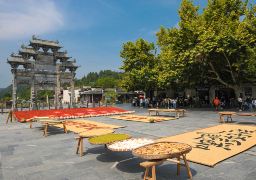Xidi, a quintessential Hui-style ancient village, is nestled 8 kilometers southeast of Yixian and 50 kilometers northwest of Huangshan City. Renowned for its architectural splendor rather than water views like its counterpart Hongcun, Xidi boasts exquisite Hui-style carvings on its buildings, with intricate details in brick, stone, and wood that seem delicate enough to break with a gentle touch. The village is further enlivened by art students who come to sketch, adding another layer of charm to the scenery.
The majority of Xidi’s residents bear the surname Hu, claiming descent from Emperor Taizong of Tang, Li Shimin, who changed their surname to Hu to escape the ravages of war. Founded during the Northern Song Dynasty, the village flourished in the Ming Dynasty and peaked in the early Qing Dynasty, with wealthy Hui merchants constructing their hometown in comfort and grandeur. The Ming and Qing architecture that stands today still radiates its former glory.
Shaped like a ship and spanning three streams, Xidi is a well-connected village with multiple entrances, the main one located at the southwest corner. The streams, flowing from east to west, give the village its name. Upon entering, visitors are greeted by the Hu Wenguang Memorial Archway, a magnificent structure built in 1578 from local ‘Yixian Blue’ marble, adorned with five levels of exquisite stone carvings. Adjacent to the archway lies the Mingjing Lake, offering reflections of Hui-style architecture.
Inside the village, at the intersection of Henglu Street, is Ruiyu Court, a representative Hui merchant residence from the Xianfeng era of the Qing Dynasty. It features thought-provoking couplets, such as one composed entirely of characters with the radical ‘walk’, which translates to ‘Greeting and sending far and near, reaching the way; advancing and retreating slowly, wandering carefree’, and another that encapsulates the philosophy of business and life: ‘Happiness often comes from hard work, and savings often come from losses’.

Heading east and crossing Qianbian Stream, one finds the Jing’ai Hall, originally built during the Wanli era of the Ming Dynasty and rebuilt in the Qianlong era of the Qing Dynasty. It is one of the larger ancestral halls in the village, once a place for the Hu family to convene, celebrate weddings, and discipline wayward descendants. The large ‘filial piety’ character hanging inside is particularly striking, with the ‘earth’ character on the right side resembling a person bowing and the left side a monkey, symbolizing that only through filial piety can one be considered human.
Continuing northeast along Qianbian Stream, the Shangde Hall, with a history of 400 years, stands as one of the oldest Ming Dynasty houses in the village. Along the way, visitors can explore Taoli Garden, a fusion of Xidi residences and libraries; Hui-style courtyards Xiyuan and Dongyuan; and Dunrentang, the residence of Hu Guan San, Xidi’s wealthiest resident during the Qing Dynasty. Other noteworthy architectural features include the Walking Horse Building, Embroidery Building, and Zhuimutang.
Visiting Xidi in March and April offers a stunning contrast of white walls, black tiles, and vibrant rapeseed flowers. However, it’s best to avoid the Qingming Festival due to the influx of tourists. The village has a high level of commercialization, with local families operating agritourism and street vendors offering snacks. One can savor the unique Huizhou cuisine, including Laba tofu, baked scones, bamboo shoots, and the hair tofu and stinky mandarin fish featured on ‘A Bite of China’.

For those seeking tranquility, staying overnight is recommended. Early morning and dusk strolls allow one to avoid the daytime crowds. Accommodations are primarily family-style inns converted from ancient buildings. After registering with an ID at the scenic area entrance, visitors can enter and exit the village as often as they like during their stay.
Xidi is a short 18 kilometers from Hongcun and 43 kilometers from the Huangshan Scenic Area, making it a convenient stop for most tourists who include Xidi, Hongcun, and Huangshan in their itinerary.The entire text is open all year round, with full-day access.
Night tour and performance content in Xidi Scenic Area:
– Spring: open from 18:00 to 20:30.
– Summer: open from 19:00 to 21:00.
– Autumn: open from 18:00 to 20:30.
– Winter: open from 17:40 to 20:00.

The above information is for reference only, and the actual information on the day prevails.
Preferential policies:
– Children under 1.2 meters (inclusive) enter for free.
– Seniors aged 65 and above enter for free with their ID or senior citizen card.
– Those aged between 60 and 65 (not inclusive of 65) enter at half price with their ID.
– People with disabilities enter for free with their disability card.
– Active-duty military personnel enter for free with their officer’s card, soldier’s card, or civilian personnel work card and ID.
– Retired military officers enter for free with valid documents.
– Veterans enter at half price with their preferential certificate and ID.
– Tour guides enter for free with their ID and original tour guide certificate.
– Minors aged between 6 and 18 (inclusive) enter at half price with their ID.
– Students with full-time undergraduate or lower-level student status enter at half price with their student ID and ID.
– Members of photography associations enter for free with their China Photography Association membership card and XX Province Photography Association membership card.
Service facilities:
– Parking lot: [Scenic Area Parking Lot]. Reference price: 15 yuan per time. Address: Xidi Town, Yixian County. Capacity: 600. Small cars 10 yuan per time, large cars 20 yuan per time.
– Mobile phone charging: Charging power sockets are available at the tourist center.
– Luggage storage: Reference price: Free. Address: Scenic Area Tourist Service Center.
– Guided tours: For individual tourists with 10 people or less (including 10 people), the charge is 90 yuan per time; for more than 10 people, an additional 5 yuan per person is charged on the base price of 90 yuan.
– Restrooms: Multiple restrooms are available, all with signs.
– Designated smoking areas: Several designated areas for smoking are set up within the scenic area, and visitors can only smoke in these designated areas.
– Vending machines: There are four vending machines in the scenic area.









